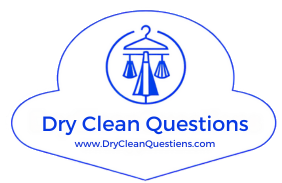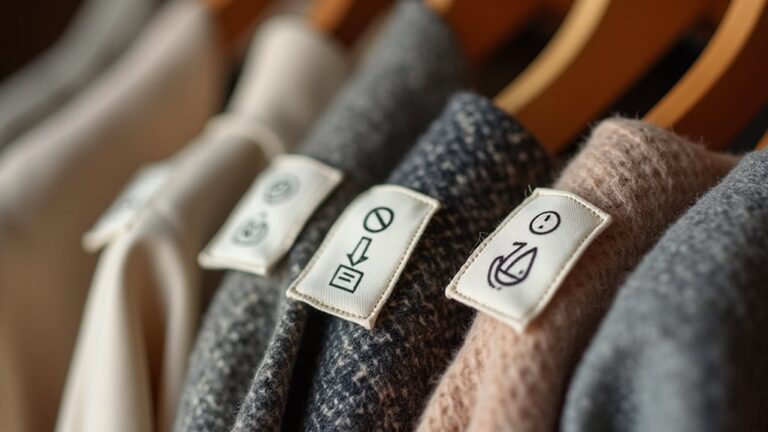You can definitely clean “dry clean only” items in your washing machine, though it’s not true dry cleaning since you’re using water instead of chemical solvents. I’ve successfully cleaned wool sweaters and delicate blouses using gentle cycles, cold water, and specialized detergents that mimic professional cleaning solutions. This method works great for lightly soiled garments, saving you $15+ per item compared to professional services. However, heavily stained pieces still need professional attention, and there’s always risk of damage with delicate fabrics like silk or items with sequins. The key is understanding which fabrics can handle this gentler approach and following proper techniques to avoid shrinkage or color bleeding. While at-home dry cleaning kits offer convenience for rejuvenating garments, they’re not miracle workers for serious stains. Smart fabric selection and careful preparation will help you master this money-saving technique.
What Is Washing Machine Dry Cleaning and How Does It Work?
Three years ago, I discovered washing machine dry cleaning after ruining my favorite silk blouse in a regular wash cycle, and honestly, it felt like finding a secret shortcut that nobody talks about.
You’re basically using your washing machine with specialized cleaning solution that’s gentler than regular detergent, mimicking what professional care does without harsh chemicals. The process works by running delicate fabrics through a gentle cycle with cold water, while the special formula lifts dirt without fabric damage.
I always use mesh bags to prevent tangling—learned that lesson the hard way with a cashmere sweater 😅. It’s perfect for lightly soiled “dry clean only” items, though heavily stained pieces still need the pros.
Traditional Dry Cleaning Vs Home Machine Methods
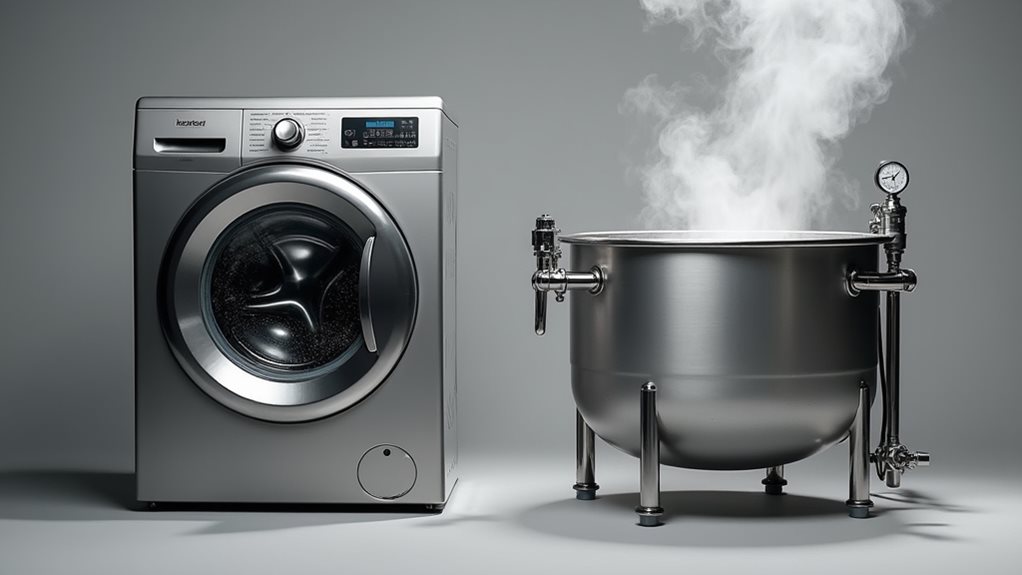
While washing machine dry cleaning works wonders for lightly soiled pieces, I’ve learned through trial and error that understanding the real differences between traditional dry cleaning and home machine methods can save you from some expensive mistakes.
Traditional dry cleaning uses liquid solvents instead of water, which means your delicate fabrics won’t shrink, lose their shape, or have colors bleeding everywhere 😅.
Home machine methods rely on water-based cleaning processes that can wreak havoc on silk blouses and wool sweaters.
I’ve discovered that oil-based stains surrender much better to professional cleaners, while your washing machine tackles water-soluble messes beautifully.
Though home methods cost less, those “dry clean only” labels exist for good reason—trust me on this one.
Professional dry cleaning also provides professional-grade stain removal capabilities that extend the lifespan of your high-quality clothing investments.
Which Fabrics Are Suitable for Machine Dry Cleaning?
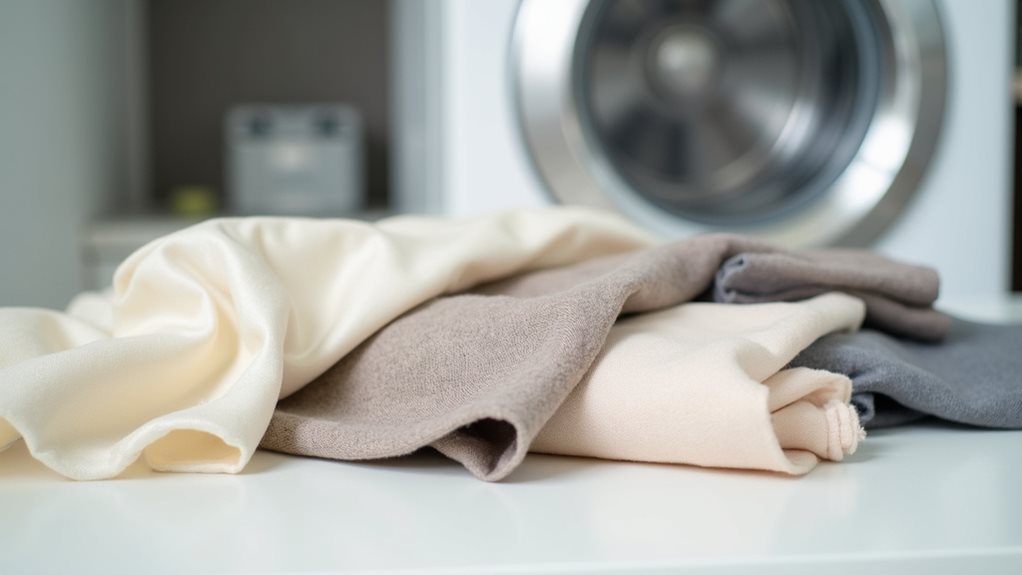
When I first started experimenting with machine dry cleaning, I quickly discovered that certain fabrics practically beg for this gentler treatment, while others will make you question every life choice that led to that moment.
Your delicate items like wool, silk, and cashmere absolutely thrive with this cleaning method, maintaining their luxurious feel without the harsh agitation of traditional washing.
I’ve found that velvet and acetate pieces emerge looking refreshed rather than traumatized, while pleated fabrics keep their crisp structure intact.
Even suede and leather can handle gentle machine dry cleaning, though you’ll want to proceed cautiously.
These fabric types benefit from the process because chemical solvents effectively remove oil-based stains that water simply cannot tackle.
Always check that care label first – fabric compatibility isn’t negotiable, and ignoring it leads to expensive learning experiences!
Step-by-Step Guide to Washing Dry Clean Only Items at Home
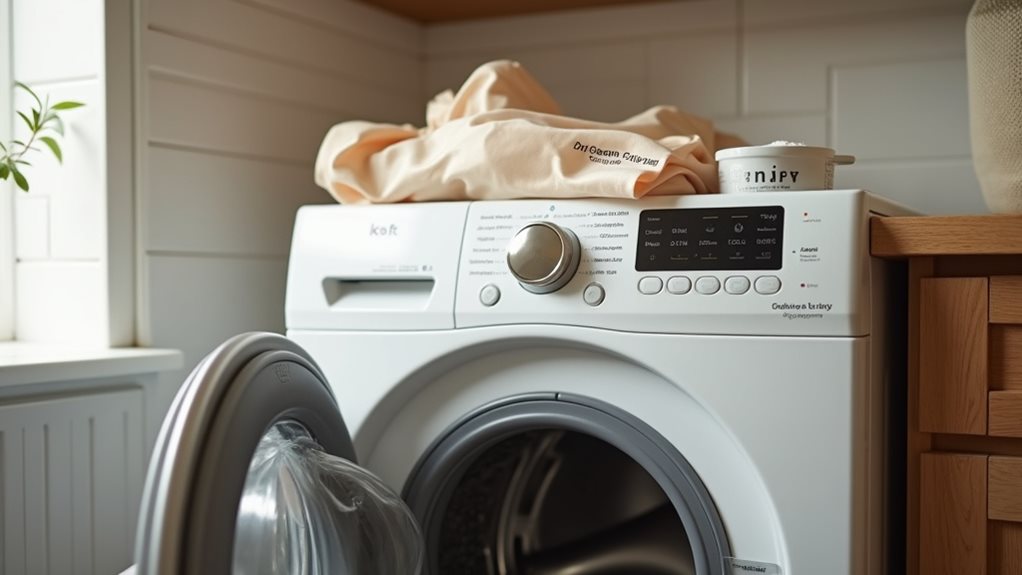
When you’re ready to take on washing those “dry clean only” labels at home, you’ll want to start with thoughtful preparation that includes checking care tags and gathering the right supplies, because trust me, I’ve learned the hard way that rushing into this without proper prep can turn your favorite blazer into doll clothes 😅.
Next, you’ll move through a gentle washing process that treats your garments like the delicate treasures they are, using cold water and protective measures that’ll keep everything intact.
Finally, proper drying methods become your best friend in this adventure, since the way you handle those wet fabrics after washing can make or break your entire at-home dry cleaning success story.
Before attempting any home cleaning method, always test on an inconspicuous area first to ensure the fabric won’t be damaged or discolored.
Pre-Wash Preparation Steps
Three simple preparation steps can mean the difference between successfully revitalizing that beautiful silk blouse at home and turning it into an expensive cleaning rag, and trust me, I’ve learned this lesson the hard way after shrinking my favorite cashmere sweater into doll clothes 😅.
First, always check the care label on your clothing because there’s an essential difference between “dry clean only” and “dry clean recommended” – the latter gives you wiggle room for home cleaning your clothes.
Items labeled “dry clean recommended” can be safely dry cleaned but don’t necessarily require it, making them better candidates for careful home cleaning than garments with mandatory professional cleaning requirements.
Next, conduct a spot test on a hidden seam using mild detergent, because discovering color bleeding after washing delicate items is heartbreaking.
Finally, secure all buttons and zippers, turn garments inside out, and place them in mesh bags before dry cleaning at home.
Gentle Washing Process
Since you’ve already done the groundwork with your preparation steps, the actual washing process becomes surprisingly manageable, though I’ll admit my hands still shake a little when I load that expensive blazer into the machine.
Select your washing machine’s delicate cycle, because this gentle setting mimics the careful treatment your clothing would receive at professional cleaners.
Add a small amount of mild detergent—less is definitely more here, since excess suds can leave residue on delicate fabrics.
Set the water temperature to cold, which prevents shrinkage and color bleeding that could ruin your favorite pieces.
Once you press start, resist the urge to peek constantly; trust the process and let the gentle cycle work its magic on your precious garments.
Remember that traditional dry cleaning uses chemical solvents instead of water, so this home washing method won’t achieve identical results but can be effective for many garments when done carefully.
Proper Drying Methods
Although the washing cycle might’ve gone effortlessly, I’ve learned the hard way that drying is where many home dry cleaning attempts meet their tragic end—like the time I confidently tossed my favorite wool sweater into the dryer and watched it emerge looking like it belonged on a toddler.
Proper drying methods are absolutely essential when you hand wash dry clean items, because heat is the enemy of delicate clothing fabrics.
Skip the dryer entirely and lay your garments flat on clean towels, gently reshaping them while damp. For items like blouses or dresses, hang them on padded hangers to maintain their structure.
If your garments do get wet during the drying process, immediate drying is recommended to prevent water spots, shrinkage, or color bleeding that can compromise the fabric’s appearance.
This patient approach guarantees your clean clothes retain their original fit and prevents the heartbreak of ruined garments—trust me, your wardrobe will thank you!
At-Home Dry Cleaning Kits: Do They Actually Work?
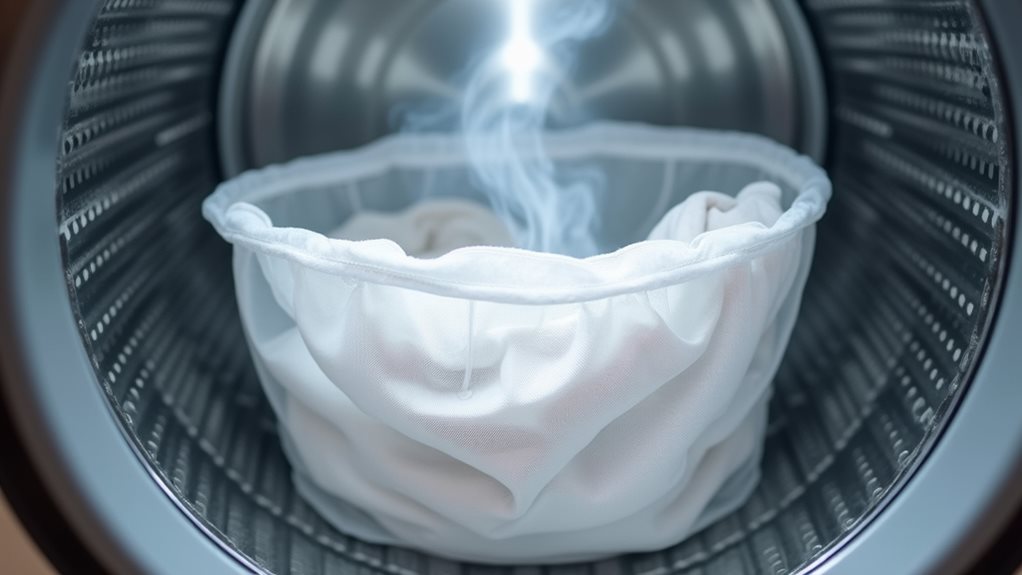
You’ve probably walked past those at-home dry cleaning kits in the laundry aisle and wondered if they’re just clever marketing or actually worth your fifteen bucks, and honestly, I’d the same skeptical eyebrow raise until I tried one on my favorite blazer.
These kits typically include special cleaning cloths, a stain treatment pen, and a protective bag that works with your dryer’s heat, though the real question isn’t what’s in the box but whether it can compete with your local dry cleaner’s professional-grade solvents and expertise.
The truth is, these convenient little packages work great for revitalizing lightly worn garments and removing minor odors, but they’re like bringing a butter knife to a steak dinner when you’re dealing with serious stains or heavily soiled items.
They’re particularly effective on garments with “dry clean only” labels that need occasional maintenance rather than intensive cleaning, making them a smart way to extend time between professional visits.
Kit Components Breakdown
The magic behind at-home dry cleaning kits lies in their surprisingly simple three-part system, and honestly, when I first opened one of these boxes, I was skeptical that such basic components could replicate what professional cleaners do with their fancy equipment.
You’ll find a stain remover pen for pre-treating spots, a gentle cleaning solution that’s much milder than harsh professional solvents, and a special dryer bag that creates steam when heated.
The cleaning solution works beautifully on delicate fabrics without the aggressive chemicals, while the steam-generating bag mimics professional equipment surprisingly well.
At-home dry cleaning kits won’t work miracles on your wedding dress, but they’ll definitely refresh clothes between professional visits 😊.
Before using any kit, always test the cleaning solution on a hidden area of the garment to check for fabric compatibility and prevent unexpected damage.
Effectiveness Vs Professional
When I decided to put my $15 at-home dry cleaning kit head-to-head against my usual $25 professional service, I honestly expected the home version to fall flat on its face, but the results surprised me in ways I didn’t anticipate.
Here’s what I discovered about their effectiveness:
- Light maintenance cleaning worked surprisingly well for revitalizing blazers and dress pants.
- Stubborn stains like red wine or grease still required professional intervention.
- Clothing marked as dry clean only showed mixed results depending on fabric delicacy.
- Time investment was notably higher with home kits versus drop-off convenience.
- Professional dry cleaning is better for valuable garments where you can’t risk damage.
- At-home kits also eliminate exposure to perchloroethylene, the chemical solvent used in traditional dry cleaning that has been classified as a probable human carcinogen.
The truth is, cleaning is more effective when you determine whether your garment needs deep restoration or simple rejuvenation
Risks and Potential Damage When Machine Washing Delicate Items
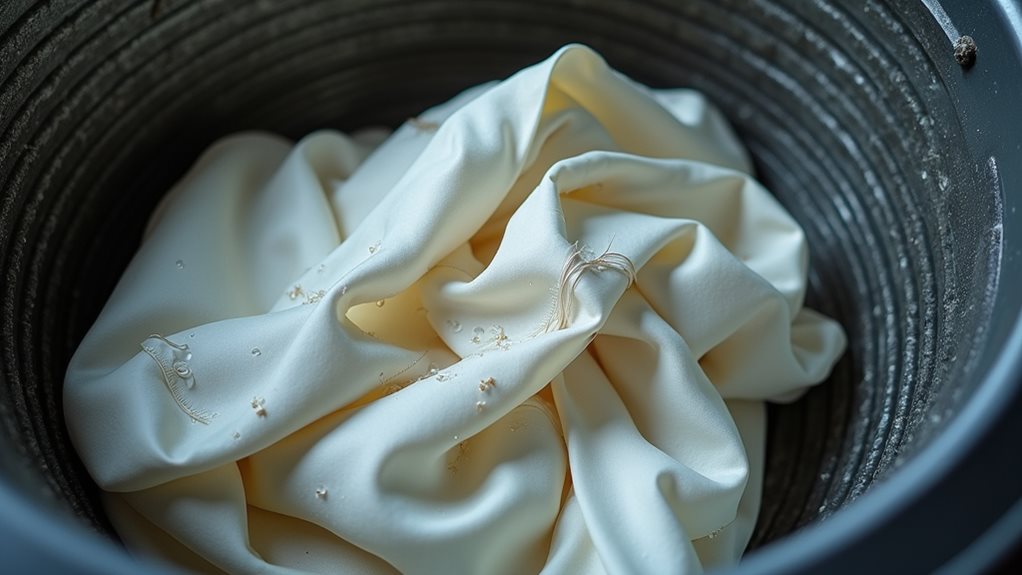
Although machine washing might seem like a harmless shortcut for those “dry clean only” garments hanging in your closet, I’ve learned through some costly mistakes that delicate items can suffer serious damage when exposed to water and agitation.
My favorite silk blouse became a wrinkled mess after one machine wash, while my wool sweater shrunk two sizes—ouch! 😅
The aggressive spinning cycles can stretch or break delicate fibers, and those beautiful sequined details? They’ll get caught and ripped off faster than you can say “wardrobe malfunction.”
Plus, machine washing simply can’t tackle oil-based stains the way professional dry cleaning can, leaving you with damaged fabrics and stubborn spots that refuse to budge.
Professional dry cleaning uses specialized solvents that cannot be replicated at home, which is why attempting conventional washing methods will likely result in permanent damage to your expensive clothing items.
Cost Comparison: Professional Services Vs Home Alternatives

After spending way too much money on dry cleaning bills over the years, I’ve become something of a detective when it comes to comparing the costs of professional services versus home alternatives, and let me tell you—the numbers can be pretty eye-opening! 💸
Professional dry cleaning typically runs between $10 to $30 per garment depending on the fabric complexity, which means that gorgeous silk dress you wore once could cost you $20 just to get clean, while those home dry cleaning kits from the drugstore hover around $10 to $20 but can handle multiple items.
That $20 silk dress cleaning bill suddenly makes those $15 home kits looking pretty tempting for your wallet!
Here’s what this cost comparison really looks like:
- Home washing averages under $2 per load versus $15+ per professional cleaning
- Home dry cleaning kits treat 4-6 clothing items for one professional service price
- Long-term savings can reach hundreds annually when switching home alternatives
- Environmental costs favor eco-friendly home detergents over chemical solvents
- Risk factor increases with delicate fabrics when choosing cheaper home methods
When to Choose Professional Dry Cleaning Over Home Methods
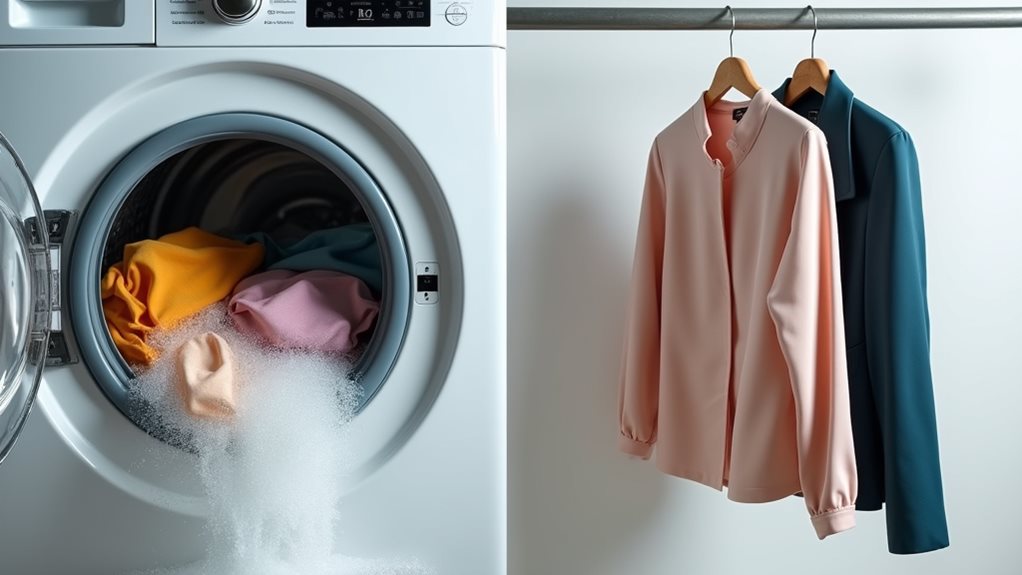
While those home alternatives can save you serious cash, I’ve learned the hard way that some garments are basically sending you a love letter that says “please don’t DIY me” when you see that dreaded “dry clean only” label staring back at you from the care tag. 😅
My expensive lesson came courtesy of a gorgeous wool blazer that I thought I could gently hand wash—spoiler alert: it ended up looking like it belonged on my ten-year-old nephew instead of me, because wool has this delightful tendency to shrink faster than my motivation on Monday mornings when exposed to water and agitation.
Professional dry cleaning becomes your best friend when you’re dealing with delicate fabrics like silk or cashmere, heavy stains that won’t budge, or anything with sentimental value that you’d cry over if home washing went sideways.
